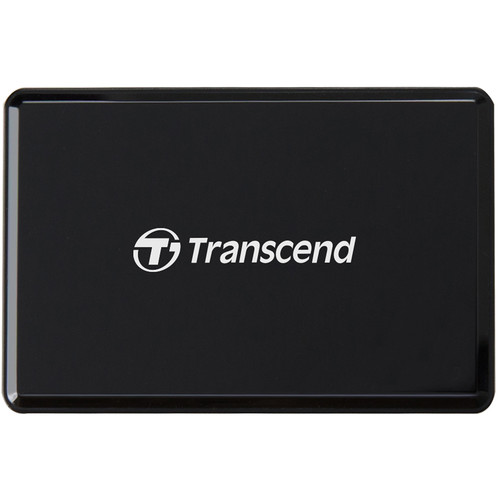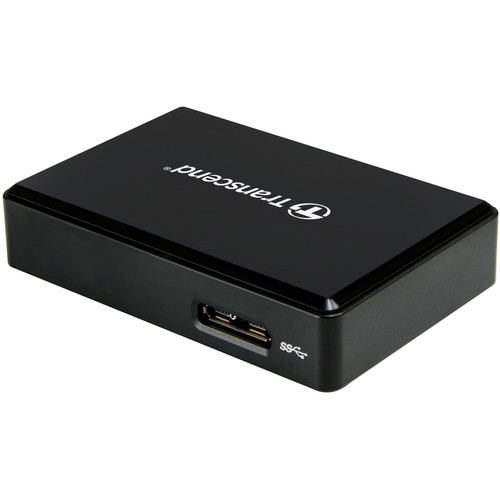Shipping time and rates:
Shipping time and rates:
Sorry, we couldn't find any shipping options for your location. Please contact us, and we'll see what we can do about it.
Yes, we can ship to
United States


Transcend RDF9 UHS-II Card Reader
EAN: 760557842675
Transfer files from SD/SDHC/SDXC, microSD/SDHC/SDXC, and CompactFlash memory cards to your Windows, Mac, or Linux system using the black RDF9 UHS-II Card Reader from Transcend. This card reader supports the 5 Gb/s USB 3.1 Gen 1 standard, which is also known as USB 3.0, and delivers read speeds of up to 260 MB/s and write speeds of up to 190 MB/s. It also supports UHS-II and UHS-I standards for SD and UHS-I for microSD cards, as well as the UDMA 7 and UMDA 6 standards for CompactFlash media. This card reader connects to your host system using its micro-USB interface and an included micro-USB to USB Type-A cable. In case of accidental file deletions or card errors, Transcend s RecoveRx software is available as a free download.
General Features
Made for UHS-II SD Cards
The RDF9 UHS-II Card Reader is here to unleash the high-speed performance of a UHS-II SD card, transferring high resolution raw images and HD videos to your computer quickly. In addition, it is backward compatible with UHS-I and any other SDXC, SDHC, and SD cards.
Fast Transfer Speeds
Taking full advantage of USB 3.1 and UHS-II technology, the read and write speeds of the RDF9 are up to 260 MB/s and 190 MB/s, respectively.
For Professionals
High speed boosts your workflow and efficiency. The RDF9 lets professional photographers, videographers, and graphic designers transfer data, including high-resolution video and raw images at high speeds, accelerating post-production processing.
SD, microSD, and CompactFlash Slots
Besides the SD card slot, the multi-functional RDF9 also has CompactFlash and microSD card slots, allowing you to transfer different types of digital files with one compact card reader.
Free RecoveRx software
Transcend s RDF9 card reader includes a free download of their RecoveRx software, a user-friendly application that allows you to conduct an in-depth search within your storage device for traces of erased data that can be recovered.
EAN: 760557842675
Transfer files from SD/SDHC/SDXC, microSD/SDHC/SDXC, and CompactFlash memory cards to your Windows, Mac, or Linux system using the black RDF9 UHS-II Card Reader from Transcend. This card reader supports the 5 Gb/s USB 3.1 Gen 1 standard, which is also known as USB 3.0, and delivers read speeds of up to 260 MB/s and write speeds of up to 190 MB/s. It also supports UHS-II and UHS-I standards for SD and UHS-I for microSD cards, as well as the UDMA 7 and UMDA 6 standards for CompactFlash media. This card reader connects to your host system using its micro-USB interface and an included micro-USB to USB Type-A cable. In case of accidental file deletions or card errors, Transcend s RecoveRx software is available as a free download.
General Features
Made for UHS-II SD Cards
The RDF9 UHS-II Card Reader is here to unleash the high-speed performance of a UHS-II SD card, transferring high resolution raw images and HD videos to your computer quickly. In addition, it is backward compatible with UHS-I and any other SDXC, SDHC, and SD cards.
Fast Transfer Speeds
Taking full advantage of USB 3.1 and UHS-II technology, the read and write speeds of the RDF9 are up to 260 MB/s and 190 MB/s, respectively.
For Professionals
High speed boosts your workflow and efficiency. The RDF9 lets professional photographers, videographers, and graphic designers transfer data, including high-resolution video and raw images at high speeds, accelerating post-production processing.
SD, microSD, and CompactFlash Slots
Besides the SD card slot, the multi-functional RDF9 also has CompactFlash and microSD card slots, allowing you to transfer different types of digital files with one compact card reader.
Free RecoveRx software
Transcend s RDF9 card reader includes a free download of their RecoveRx software, a user-friendly application that allows you to conduct an in-depth search within your storage device for traces of erased data that can be recovered.
No posts found




























